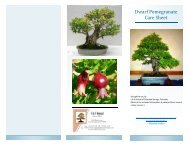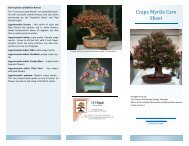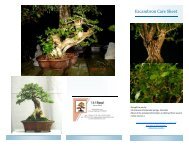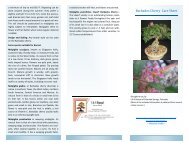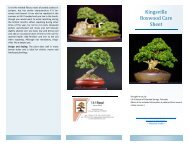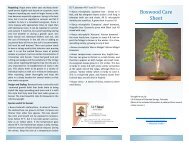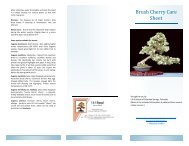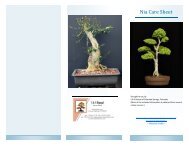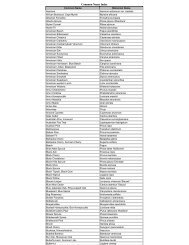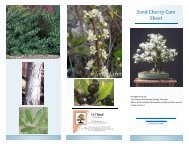Cotoneaster Care Sheet
Cotoneaster Care Sheet
Cotoneaster Care Sheet
Create successful ePaper yourself
Turn your PDF publications into a flip-book with our unique Google optimized e-Paper software.
<strong>Cotoneaster</strong> <strong>Care</strong><br />
<strong>Sheet</strong><br />
Brought to you by<br />
S & S Bonsai of Colorado Springs, Colorado<br />
(Most of the included information is obtained from several<br />
online sources.)<br />
“Live as if you were to die tomorrow. Learn as if<br />
you were to live forever.”<br />
—Mahatma Gandhi—
The <strong>Cotoneaster</strong><br />
(<strong>Cotoneaster</strong> sp.)<br />
General Information: <strong>Cotoneaster</strong>s are prime<br />
picks for a bonsai project. The word cotoneaster<br />
is widely mispronounced. The correct<br />
pronunciation is "Cot-o-ne-as-ter." They are a<br />
broadleaf shrub that has small leaves and<br />
some very good characteristics that make<br />
them perfect bonsai specimens. In the Rose<br />
(Rosaceae) family, they are tolerant of heavy<br />
pruning and human error. This native of China<br />
and the Himalayas has a multi-seasonal appeal.<br />
There are many varieties of cotoneasters.<br />
The most popular species for bonsai is cotoneaster<br />
horizontalis, also known as Rockspray<br />
cotoneaster. Hardy in zones 5-8, it<br />
stands up to cold better than most <strong>Cotoneaster</strong>s.<br />
This species is amazing as you will see so<br />
many changes taking place within this plant.<br />
It is a great choice because it grows very<br />
quickly, produces its flowers early, has small<br />
leaves, and even bears fruits when it is still<br />
very young. This variety has been a beautiful<br />
specimen and has done very well in shows. It<br />
has beautiful colors. You will see light and<br />
dark green in the foliage, which is then followed<br />
by either white, red, or pink blooms.<br />
The foliage of cotoneaster horizontalis will<br />
change from light green to dark green as the<br />
seasons change. This is followed by bright red<br />
fruit that is an eye-pleaser for sure. This variety<br />
will keep its fruit up until late fall or early<br />
winter, but will drop its leaves if you live in<br />
colder climates.<br />
CARE<br />
Temperature: Zone 4-7, depending on the<br />
species, with winter protection below freezing.<br />
In warmer areas, up to zone seven and eight,<br />
cotoneaster will be evergreen, where as in<br />
colder climates they will loose their foliage in<br />
the winter. <strong>Cotoneaster</strong> still require a period<br />
of cooler weather to thrive, though do not<br />
need to go below freezing. Most <strong>Cotoneaster</strong>s<br />
do well in hot climates.<br />
Lighting: Varies according to variety, but most<br />
need full sun to partial shade.<br />
Air: Protect from strong, cold winds.<br />
Watering: As necessary in summer. Never allow<br />
to completely dry out, but do not over<br />
water. Lower water in winter, just enough to<br />
keep from dehydrating. <strong>Cotoneaster</strong> do not<br />
like wet feet!<br />
Fertilizing: Every two weeks with an balanced<br />
fertilizer during spring (after flowering) and<br />
summer. Use half-strength plant food. Nitrogen<br />
free in late summer and fall, tapering off<br />
to nothing in winter.<br />
Pruning / Training: <strong>Cotoneaster</strong> likes to<br />
sucker, so if it is not being grown as a clump,<br />
suckers must be vigilantly removed to promote<br />
trunk growth. <strong>Cotoneaster</strong> tolerate very<br />
heavy pruning. Prune back to old stems, as<br />
cotoneaster will back bud to old wood. Trim<br />
back to one or two leaves in late spring from<br />
new growth, cutting just above a leaf node.<br />
<strong>Cotoneaster</strong> have herringbone patterned<br />
branches, as new branches emerge from the<br />
base of every leaf stalk in midsummer or following<br />
spring, so rebuilding and forming<br />
branches is very predictable. Shape existing or<br />
new branches by cutting back to a leaf facing<br />
in the direction you want the new branch to<br />
grow. <strong>Cotoneaster</strong> are vigorous growers, and<br />
constant attention to remove unwanted<br />
shoots and keeping the canopy from becoming<br />
over crowded is a must. Main trunks can<br />
tend toward the thin side, but thickening can<br />
be encouraged by cutting down suckers at the<br />
base as they grow. Also try planting these in<br />
the ground, as they are particularly slow to<br />
thicken in a pot. Wire in spring, before bud<br />
break if necessary.<br />
Insects / Pests: Leaf blight and fireblight.<br />
Mites, aphids, scale, lace bugs.<br />
Propagation: Seeds, softwood cuttings in<br />
summer, layering. Cuttings may be taken in<br />
June-July, and should take about six weeks to<br />
root. Air-layering may be used as well; the<br />
most optimal time is during bud-swelling in<br />
the spring. <strong>Cotoneaster</strong> may be grown from<br />
seed collected from the berries in fall, but<br />
seed grown plants are inferior to other methods.<br />
The seeds must be cold treated and<br />
sown in early spring.<br />
Repotting: Every one to two years in spring,<br />
removing up to one third of the root system.<br />
<strong>Cotoneaster</strong> does not like to be bare-rooted.<br />
Well draining soil, about 50% organic, 50%<br />
grit.<br />
Design and Styling: Cascade, semi-cascade,<br />
mame, clump, root-over-rock, exposed root,<br />
slanting, multi-trunked. <strong>Cotoneaster</strong>s lend<br />
themselves to mame and shohin, but are<br />
harder to grow as large bonsai.
Some species suitable for bonsai:<br />
<strong>Cotoneaster</strong> adpressa (adepressus)- Creeping<br />
<strong>Cotoneaster</strong>, a deciduous cotoneaster<br />
with pink flowers, red fruit and good red autumn<br />
color. Dark glossy leaves. Hardy to zone<br />
4b.<br />
<strong>Cotoneaster</strong> adpressa praecox - similar to the<br />
above, but has better autumn color and<br />
brighter fruits.<br />
<strong>Cotoneaster</strong> apiculata (apiculatus): cranberry<br />
cotoneaster. Creeping habit. Shiny green<br />
leaves with undulating margins, red to purplish-red<br />
color in autumn. White flowers<br />
flushed red; round red fruits. Zone 4.<br />
<strong>Cotoneaster</strong> congesta (congustus): congested<br />
cotoneaster, Pyrenees cotoneaster.<br />
Mounding habit. Dull bluish-green leaves- an<br />
evergreen shrub with white flowers and red<br />
fruit. Very small, and especially good for<br />
mame. Zone 6.<br />
<strong>Cotoneaster</strong> conspicuus decorus - Smallleaved<br />
evergreen with red fruit. Its most notable<br />
feature is its fragrant white flowers,<br />
which open fully to resemble wild roses. Another<br />
advantage - birds don't seem to like the<br />
taste of this <strong>Cotoneaster</strong>'s fruit.<br />
<strong>Cotoneaster</strong> dammeri: Bearberry cotoneaster.<br />
Creeping evergreen to semi-evergreen<br />
shrub. Leaves dark green in summer and<br />
autumn, dull green and purple in winter.<br />
White flowers, scanty red fruit. 'Royal beauty'<br />
has more abundant, coral fruit. Zone 5. Similar<br />
to Skogholm cotoneaster.<br />
<strong>Cotoneaster</strong> divaricatus: spreading cotoneaster<br />
- Native to China, this <strong>Cotoneaster</strong> grows<br />
to six feet. Upright but spreading habit. It has<br />
bright red berries pink flowers, and a fine<br />
show of autumn color before losing its leaves.<br />
Hardy in zones 5-8, it stands up to cold better<br />
than most <strong>Cotoneaster</strong>s. More disease and<br />
pest resistant.<br />
<strong>Cotoneaster</strong> horizontalis: rockspray cotoneaster<br />
- A broad-leaved shrub, hardy to zone six.<br />
Dense, mounding habit. The rockspray cotoneaster<br />
has white or pink flowers and very nice<br />
autumn colors in areas where it is deciduous.<br />
Its herringbone growth pattern and wide<br />
leaves are not typical of the genus, although it<br />
is one of the most popular varieties for bonsai.<br />
Zone 5.<br />
<strong>Cotoneaster</strong> horizontalis 'Variegatus': variegated<br />
rockspray - less vigorous than the species,<br />
but has cream and green patterning on<br />
the leaves and pink fruit.<br />
<strong>Cotoneaster</strong> integerrima (integerrimus):<br />
common cotoneaster, European cotoneaster.<br />
Taller, rangy habit, up to 9 feet tall in landscape.<br />
Pinkish white flowers in late spring. Bluish-green<br />
foliage with little fall color. .<br />
<strong>Cotoneaster</strong> lucida: also <strong>Cotoneaster</strong> acutifolius<br />
- Peking <strong>Cotoneaster</strong>: hedge cotoneaster.<br />
Upright habit, up to 8 feet tall in landscape.<br />
Black fruit, small dark green foliage that<br />
turns yellow to red in autumn. This is a specie<br />
of cotoneaster that can be classified as a deciduous<br />
species because its loosing it's leaves<br />
in winter. Zone 4 to 8.<br />
<strong>Cotoneaster</strong> microphyllus (C.integrifolius) -<br />
Recommended as a good candidate for indoor<br />
bonsai, this evergreen has white flowers and<br />
red fruit. Its slender, pointy leaves are glossy<br />
dark green. Little leaf cotoneaster. Dwarf<br />
shrub. Semi-evergreen to fully evergreen.<br />
Miniature shiny, dark green leaves on top, grayish<br />
fuzz below. White flowers, bright red fruit.<br />
<strong>Cotoneaster</strong> microphyllus 'Cochleatus':<br />
dwarf creeping cotoneaster - another good<br />
potential indoor bonsai.<br />
<strong>Cotoneaster</strong> microphyllus 'Thymifolius':<br />
thyme-leaf cotoneaster - This plant has the<br />
smallest leaves of any <strong>Cotoneaster</strong>. It has pink<br />
flowers, red fruits, and is hardy to zone 5.<br />
<strong>Cotoneaster</strong> multiflorus: many-flowered<br />
cotoneaster - A large and showy plant, this is<br />
the <strong>Cotoneaster</strong> to choose for large size bonsai.<br />
It has large, red, conspicuous fruit and<br />
showy clusters of white flowers. It grows to<br />
ten feet, and has two-inch leaves that turn<br />
yellow in autumn before leaf fall. Hardy in<br />
zones 5-7, another good cold-weather choice.<br />
<strong>Cotoneaster</strong> simmonsii - This <strong>Cotoneaster</strong><br />
can be deciduous or evergreen, depending on<br />
conditions. It has pink flowers, red fruit, and<br />
small, leathery leaves which may turn scarlet<br />
in autumn.<br />
<strong>Cotoneaster</strong> 'Skogholm' - An evergreen<br />
dwarf, with large oval fruit, coral red in color.<br />
<strong>Cotoneaster</strong> salicifolia (Willow leaf cotoneaster.)<br />
Small dark green leaves, very small pink<br />
flowers, bright red berries and reddish foliage<br />
in fall. Water heavily. Soil must be well<br />
drained and may become dry between waterings.<br />
Fertilize with half strength high phosphorus<br />
(middle number) fertilizer.




